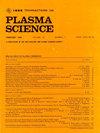使用有损后向电路波的前向空间电荷波放大器
IF 1.3
4区 物理与天体物理
Q3 PHYSICS, FLUIDS & PLASMAS
引用次数: 0
摘要
以前对超材料增强型电阻壁放大器(MERWA)的研究预测,其增益和带宽特性对高功率微波(HPM)应用很有吸引力。MERWA 理论在光束与有损耗负容限超材料 (MTM) 板之间的边界使用了横向导纳匹配 (AM) 技术,预测如果墙壁对光束具有阻抗-电感导纳,就会发生前向慢速空间电荷波增长。我们的研究表明,MERWA 的增长和带宽可以通过波耦合理论等效预测。主要的相互作用发生在两个耦合波(CW)之间,这两个波分别对应于弱耦合极限下的光束慢空间电荷波和有损后向传播电路波。我们提出了一个双波耦合模型来建立直观性,并从阻尼反馈系统的角度讨论了振荡和放大两种工作模式。我们将双波耦合解与四波模型解进行了比较。我们进一步证明并讨论了调幅模型与无限平行板几何形状的波耦合模型之间的等效性。最后,我们利用粒子入胞(PIC)模拟验证了调幅方法的预测结果。本文章由计算机程序翻译,如有差异,请以英文原文为准。
Forward Space Charge Wave Amplifiers Using Lossy Backward Circuit Waves
Previous studies of the metamaterial-enhanced resistive wall amplifier (MERWA) predicted gain and bandwidth properties attractive for high-power microwave (HPM) applications. The MERWA theory used a transverse admittance matching (AM) technique at the boundary between the beam and a lossy negative-permittivity metamaterial (MTM) slab to predict that forward slow space charge wave growth should occur if the wall presents a resistive-inductive admittance to the beam. We show that the growth and bandwidth of the MERWA can be equivalently predicted via wave-coupling theory. The main interaction occurs between two coupled waves (CWs) that correspond to the beam slow space charge wave and a lossy backward propagating circuit wave in the limit of weak coupling. We present a two-wave-coupling model to build intuition and discuss two modes of operation, oscillation and amplification, in terms of a damped feedback system. We compare the two-wave-coupling solutions against four-wave model solutions. We further demonstrate and discuss equivalency between the AM model and the wave-coupling model for an infinite parallel plate geometry. Finally, we validate the AM method predictions using particle-in-cell (PIC) simulations.
求助全文
通过发布文献求助,成功后即可免费获取论文全文。
去求助
来源期刊

IEEE Transactions on Plasma Science
物理-物理:流体与等离子体
CiteScore
3.00
自引率
20.00%
发文量
538
审稿时长
3.8 months
期刊介绍:
The scope covers all aspects of the theory and application of plasma science. It includes the following areas: magnetohydrodynamics; thermionics and plasma diodes; basic plasma phenomena; gaseous electronics; microwave/plasma interaction; electron, ion, and plasma sources; space plasmas; intense electron and ion beams; laser-plasma interactions; plasma diagnostics; plasma chemistry and processing; solid-state plasmas; plasma heating; plasma for controlled fusion research; high energy density plasmas; industrial/commercial applications of plasma physics; plasma waves and instabilities; and high power microwave and submillimeter wave generation.
 求助内容:
求助内容: 应助结果提醒方式:
应助结果提醒方式:


